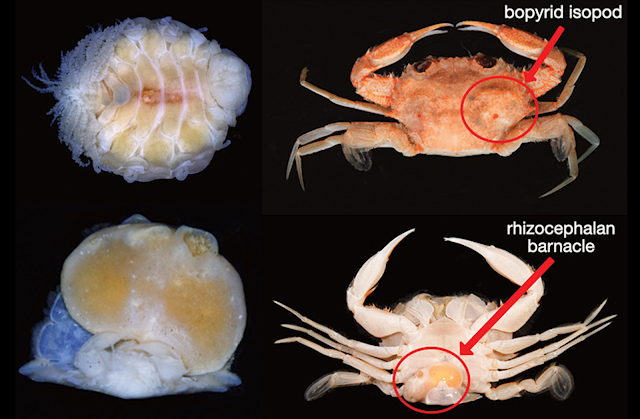Crabs have some pretty scary parasites infecting them. They range from worms that use them as vehicles to complete their complex life cycles, to parasitic dinoflagellates that turn their muscles into bitter slurry, and on top of those, there are also other crustaceans that can take over their body, and in some cases, castrate them in the process. These body-snatching crustaceans come in two main types - bopyrids and rhizocephalans.
 |
| Top: Bopyrid isopod and an infected crab, Bottom: Rhizocephalan barnacle with infected crab. Photos modified from the graphical abstract of the paper |
Bopyrids are parasitic isopods in the same suborder as the infamous tongue biter parasite, but instead of going into a fish's mouth, they go inside the body of crabs and make themselves at home, often causing a characteristic bulge on the infected crab's carapace. And then, you have the rhizocephalans, which are freaky barnacles that have a body composed of a network of roots which wrap themselves around the crab's internal organs.
Each of them inflict their own respective flavour of pain on their crab hosts.
This study looked at the effects that these parasitic crustaceans have on the two-spotted swimming crab (Charybdis bimaculata), which is host to both parasitic isopods and barnacles. Here representing the bopyrid isopods, we have a species named Allokepon hendersoni. And fronting for the barnacles, is an as yet undescribed species of rhizocephalan. As hinted at earlier, these two body-snatcher parasites seem to have different effects on the crabs - but what exactly are they?
When scientists compared infected crabs with uninfected crabs, they found the effects to be most pronounced in male crabs, with both species of parasites causing a reduction in weight and claw size of their hosts. This is most likely due to the energetic drain associated with hosting these crustaceans, since they can grow to alarmingly large sizes when compared with their hosts.
While reducing the claw size may leave the host crab less able to compete with uninfected males, on another hand (or claw as the case may be), it would not be in the interest of the parasite for its host to be getting into too many fights and risk injuries anyway, so it can be a beneficial side-effect from the parasite's perspective
But there were some changes which were more specific to particular parasite species. Male crabs infected with Allokepon had a narrower abdominal flap (the triangular flap on the "belly" of a crab). In male crabs, this flap would usually serve to protect the gonopods - which are specialised appendages that arthropods use in reproduction - but given the crab is already hosting such a demanding resident in its body, it wouldn't be getting up to any of that any time soon.
In contrast, the rhizocephalan barnacle had the opposite effect on the crab and widened that flap - this is part of a whole suite of changes that these parasites induce in male hosts. Male crabs that are infected by rhizocephalans develop characteristics which are associated with female crabs in both appearance and behaviour. In female crabs, the wider abdominal flap serves to cradle and brood the eggs before they hatch. So the barnacle essentially "feminise" the male crabs so that they can become better babysitters for the barnacle's offspring.
Fortunately for this crab population, infection rate was very low. Of the 2601 crabs the scientists examined, only 14 were infected with the isopod, and 21 infected with the rhizocephalan barnacle, though the isopod seems to have a preference for infecting male crabs, whereas the barnacle was less discriminate.
But if you are the unfortunate crab that gets infected, you are in for a bad time either way.
Reference:
Corral, J. M., Henmi, Y., & Itani, G. (2021). Differences in the parasitic effects of a bopyrid isopod and rhizocephalan barnacle on the portunid crab, Charybdis bimaculata. Parasitology International, 81: 102283.